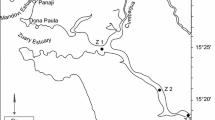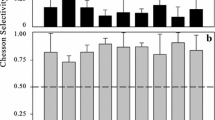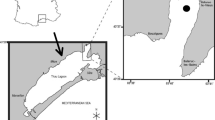Abstract
The aim of the study was to determine whether bacteria could be a substantial source of carbon for zooplankton and whether the grazing pressure of these metazoan filter-feeders could influence the fate of bacterial production. Eight grazing experiments using natural bacteria labelled with3H thymidine were conducted in a tropical pond (Ivory Coast) during various phases of biological colonization (rotifer-dominated and copepod-dominated phases of the colonization). Higher grazing and clearance rates were observed with rotifers (Brachionus plicatilis andHexarthra intermedia), while very low values were obtained when the cyclopoid copepodApocyclops panamensis was dominant. Less than 1% of the bacterial production was harvested when copepods were dominant, whileB. plicatilis consumed up to 36% of this production. However, this consumption of bacteria appeared to contribute only to an insignificant proportion of the daily carbon intake (e.g. 0.9 to 7.1% of body carbon for rotifers). The low contribution of bacteria in the nutrition of zooplankton is discussed in terms of their cell size and their relative abundance in the total amount of seston available.
Similar content being viewed by others
References
ARFI, R., D. GUIRAL and J.P. TORRÉTON, 1991. Natural recolonization in a productive tropical pond: day to day variations in the photosynthetic parameters. Aquat. Sci., 53: 39–54.
BEAVER, J.R. and T.L. CRISMAN, 1989. The role of ciliated protozoa in pelagic freshwater ecosystems. Microb. Ecol., 17: 111–136.
BERN, L., 1987. Zooplankton grazing on methyl3H thymidine labelled natural particle assemblages: determination of filtering rates and food selectivity. Freshw. Biol., 17: 151–159.
BJORNSEN, P.K., J.B. LARSEN, O. GEERTZ-HANSEN and M. OLESEN, 1986. A field technique for the determination of zooplankton grazing on natural bacterioplankton. Freshw Biol., 16: 245–253.
BOGDAN, K.G. and J.J. GILBERT, 1982. Seasonal patterns of feeding by natural populations ofKeratella, Polyarthra andBosmina: clearance rates, selectivities and contributions to community grazing. Limnol. Oceanogr., 27: 918–934.
BONOU, C.A., 1990. Etude de la productivité planctonique dans les étangs d'aquaculture en milieu saumatre tropical. Thesis Doct. Sci. Agron. Toulouse, 227 pp.
BOON, P.I. and R.J. SHIEL, 1990. Grazing on bacteria by zooplankton in Australia Billalongs. Austral. J. Mar. Freshw. Res., 41: 247–257.
CAUMETTE, P., M. PAGANO and L. SAINT JEAN, 1983. Repartition verticale du phytoplancton, des bactéries et du zooplancton dans un milieu stratifié en baie de Biétri, Lagune Ebrié, Côte d'Ivoire. Relations trophiques. Hydrobiologia, 106: 135–148.
FORSYTH, D.J. and M.R. JAMES, 1984. Zooplankton grazing on lake bacterioplankton and phytoplankton. J. Plankton Res., 6: 803–810.
FUHRMAN, J.A. and F. AZAM, 1982. Thymidine incorporation as a measure of heterotrophic bacterioplankton production in marine surface waters: evaluation and field results. Mar. Biol., 66: 109–120.
GLIWICZ, Z.M., 1969. The share of algae, bacteria and trypton in the food of the pelagic zooplankton of lakes with various trophic characteristics. Hydrobiology, 17: 159–165.
GRIFFITH, F.B. and J. CAPERON, 1979. Description and use of an improved method for determining estuarine zooplankton grazing rates on phytoplankton. Mar. Biol., 54: 301–309.
GÜDE, H., 1986. Loss processes influencing growth of planktonic bacterial populations in lake Constance. J. Plankton Res., 8: 795–810.
GUDE, H., 1989. The role of grazing on bacteria in plankton succession. In: U. Sommer, Ed., Plankton Ecology. Springer Verlag, p. 337–364.
GUIRAL, D., R. ARFI, M. BOUVY, M. PAGANO and L. SAINT-JEAN. 1994. Ecological organization and succession during natural recolonization of a tropical pond. Hydrobiologia. In press.
HART, R.C. and A.C. JARVIS, 1993.In situ determinations of bacterial selectivity and filtration rates by five cladoceran zooplankters in a hyper trophic subtropical reservoir. J. Plankt. Res., 15: 295–315.
LEGENDRE, M., M. PAGANO and L. SAINT-JEAN, 1987. Peuplements et biomasse zooplanctonique dans des étangs de pisciculture lagunaire, Layo Côte d'Ivoire. Etude de la recolonisation après la mise en eau. Aquaculture, 67: 321–341.
MULLIN, M.M., 1983.In situ measurement of filtering rates of the salp,Thalia democratica, on phytoplankton and bacteria. J. Plankton Res., 5: 279–288.
NAGATA W.D., 1989. Nitrogen flow through aBrachionus/Chlorella mass culture system. Hydrobiologia, 186/187: 401–408.
NAGATA, T. and K. OKAMOTO, 1988. Filtering rates on natural bacteria byDaphnia longispina andEodiaptomus japonicus in lake Biwa. J. Plankton Res., 10: 835–850.
NIVAL, P. and S. NIVAL, 1976. Particle retention efficiencies of an herbivorous copepodAcartia clausi adult and copepodite stages: effects on grazing. Limnol. Oceanogr., 21: 24–38.
PACE, M.L., 1988. Bacterial mortality and the fate of bacterial production. Hydrobiologia, 159: 179–188.
PACE, M.L., K.G. PORTER and Y.S. FEIG, 1983. Species and age-specific differences in bacterial utilization by two co-occurring cladocerans. Ecology, 64: 1145–1156.
PEDROS-ALIO, C. and T.D. BROCK, 1983. The impact of zooplankton feeding on the epilimnetic bacteria of a eutrophic lake. Freshw. Biol., 13: 227–239.
PORTER, K.G. and Y.S. FEIG, 1980. The use of DAPl for identifying and counting aquatic microflora. Limnol. Oceanogr., 25: 943–948.
POURRIOT, R., 1977. Food and feeding habits of Rotifera. Archiv Hydrobiol. Ergebnisse Limnol. 8: 243–260.
POURRIOT, R., J. CAPBLANCQ, P. CHAMP and J.A. MEYER, 1982. Ecologie du plancton des eaux continentales. Masson, Paris.
RIEMANN, B., 1985. Potential importance of fish predation and zooplankton grazing on natural populations of freshwater bacteria. Appl. Environ. Microbiol., 50: 187–193.
RIEMANN, B. and S. BOSSEMANN, 1984.Daphnia grazing on natural populations of bacteria. Verh. Internat. Verein. Limnol., 22: 795–799.
ROTHHAUPT, K.O. 1990. Differences in particle size-dependent feeding efficiencies of closely related rotifer species. Limnol. Oceanogr., 35: 16–23.
SANDERS, R.W., K.G. PORTER, S.J. BENETT and A.E. DEBIASE, 1989. Seasonal patterns of bacterivory by flagellates, ciliates, rotifers and cladocerans in a freshwater planktonic community. Limnol. Oceanogr., 34: 673–687.
SCAVIA, D. and G.A. LAIRD, 1987. Bacterioplankton in lake Michigan: dynamics, controls and significance to carbon flux. Limnol. Oceanogr., 32: 1017–1033.
SEAMAN, M.T., M. GOPHEN, B.Z. CAVARI and B. AZOULAY, 1986.Brachionus calyciflorus Pallas as agent for the removal of E. coli in sewage ponds. Hydrobiologia. 135: 55–60.
SHERR, B.F. and E.B. SHERR, 1984. Role of heterotrophic protozoa in carbon and energy flow in aquatic environments. In: M.J. Klug and CA. Reddy, Eds., American Society Microbiology, p. 412–423.
SIMON, M. and F. AZAM, 1989. Protein content and protein synthesis rates of planktonic marine bacteria. Mar. Ecol. Prog. Ser., 51: 203–213.
STARKWEATHER, P.L., J.J. GILBERT and T.M. FROST, 1979. Bacterial feeding by the rotiferBrachionus calyciflorus: clearance and ingestion rates and population dynamics. Oecologia, 44: 26–30.
TORRÉTON, J.P., 1991. Importance des bactéries hétérotrophes aérobies dans une lagune eutrophe tropicale, Lagune Ebrié, Côte d'lvoire. Biomasse, production, exportations. Thesis Doct. Univ., Aix-Marseilles.
TORRÉTON, J.P. and M. BOUVY, 1991. Estimating bacterial DNA synthesis from3H-thymidine incorporation: discrepancies among macromolecular extraction procedures. Limnol. Oceanogr., 36: 299–306.
TURNER, J.T. and P.A. TESTER, 1992. Zooplankton feeding ecology: bacterivory by metazoan microzooplankton. J. Exp. Mar. Biol. Ecol., 160: 149–167.
WYLIE, J.L. and D.J. CURRIE, 1991. The relative importance of bacteria and algae as food sources for crustacean zooplankton. Limnol. Oceanogr., 36: 708–728.
Author information
Authors and Affiliations
Rights and permissions
About this article
Cite this article
Bouvy, M., Arfi, R., Guiral, D. et al. Role of bacteria as food for zooplankton in a eutrophic tropical pond (Ivory Coast). Netherlands Journal of Aquatic Ecology 28, 167–174 (1994). https://doi.org/10.1007/BF02333987
Issue Date:
DOI: https://doi.org/10.1007/BF02333987




